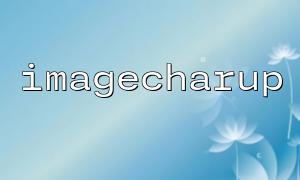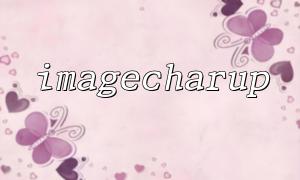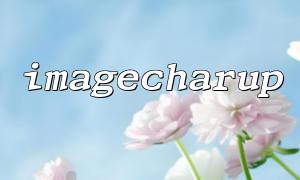In PHP, the imagecharup function allows you to draw characters on an image and set different colors for each character. This is particularly useful for generating image CAPTCHAs, dynamic text images, or creating images with dynamic text. However, when working with transparent background images, ensuring that the characters blend well with the background is a crucial detail that requires special attention.
This article will introduce how to achieve the best visual effect by using the imagecharup function in PHP along with transparent background images.
First, we need to create an image with a transparent background. This can be done using the imagecreatetruecolor function by specifying a transparent color and setting its transparency.
<?php
// Create an image with a transparent background
$width = 200;
$height = 100;
$image = imagecreatetruecolor($width, $height);
<p>// Create transparent background<br>
$transparent = imagecolorallocatealpha($image, 0, 0, 0, 127);<br>
imagefill($image, 0, 0, $transparent);</p>
<p>// Enable image transparency<br>
imagesavealpha($image, true);<br>
?><br>
In the above code, imagecolorallocatealpha creates a fully transparent color (with an alpha value of 127). The imagesavealpha function ensures the image retains transparency.
Next, we can use the imagecharup function to draw characters on the transparent background. The imagecharup function allows you to draw characters that are arranged vertically.
For the best effect, you should choose an appropriate font and size. If you use a bold font, the characters may contrast well with the background. On the other hand, if the font is thin or the background is complex, you may need to adjust the character color to ensure it is clearly visible in the image.
<?php
// Set character color
$textColor = imagecolorallocate($image, 255, 255, 255); // White
<p>// Set text content, position, and font size<br>
$text = 'Hello!';<br>
$fontSize = 5; // Use built-in font<br>
$x = 50;<br>
$y = 50;</p>
<p>// Draw character<br>
imagecharup($image, $fontSize, $x, $y, $text, $textColor);<br>
?><br>
In this code, the imagecharup function draws the string "Hello!" on the transparent background image. You can adjust $x and $y to position the characters, and choose a suitable color to ensure sufficient contrast with the background.
The color of characters in a transparent background image is crucial. If the background itself is transparent, using very light colors might render the characters invisible. You can use darker colors to ensure the characters stand out.
<?php
// Use black characters
$textColor = imagecolorallocate($image, 0, 0, 0); // Black
<p>// Draw character<br>
imagecharup($image, $fontSize, $x, $y, $text, $textColor);<br>
?><br>
Similarly, you can adjust the character's transparency in combination with the background image's transparency to achieve the best visual effect.
Finally, ensure the image is output correctly. We typically use the header function to set the correct image MIME type and then output the image using either the imagepng or imagejpeg functions.
<?php
// Set image content type
header('Content-Type: image/png');
<p>// Output image<br>
imagepng($image);</p>
<p>// Destroy image resource<br>
imagedestroy($image);<br>
?><br>
The above code will output the image as a PNG format directly. Since the image has a transparent background, PNG format is highly suitable for this purpose.
If you need to load external resources or generate dynamic links during the implementation, you can use the following example URL:
<span class="fun">https://gitbox.net/path/to/resource</span>In actual development, you can replace it with the specific resource path or API address as needed.





